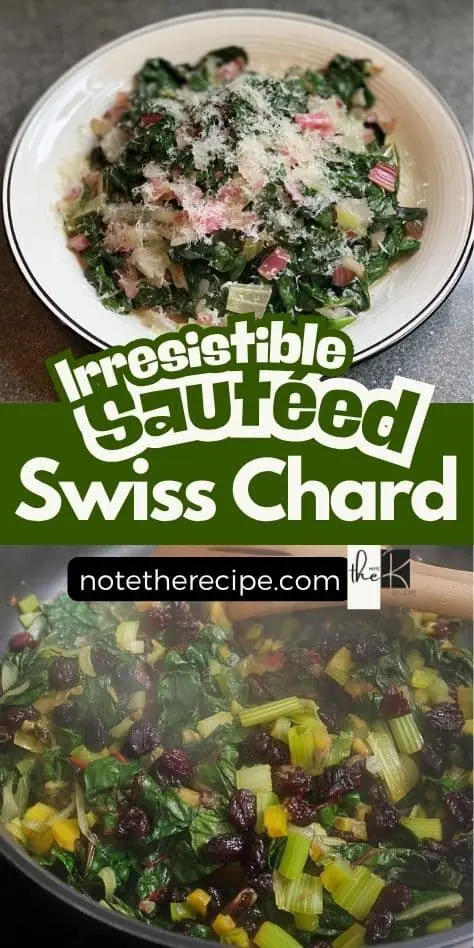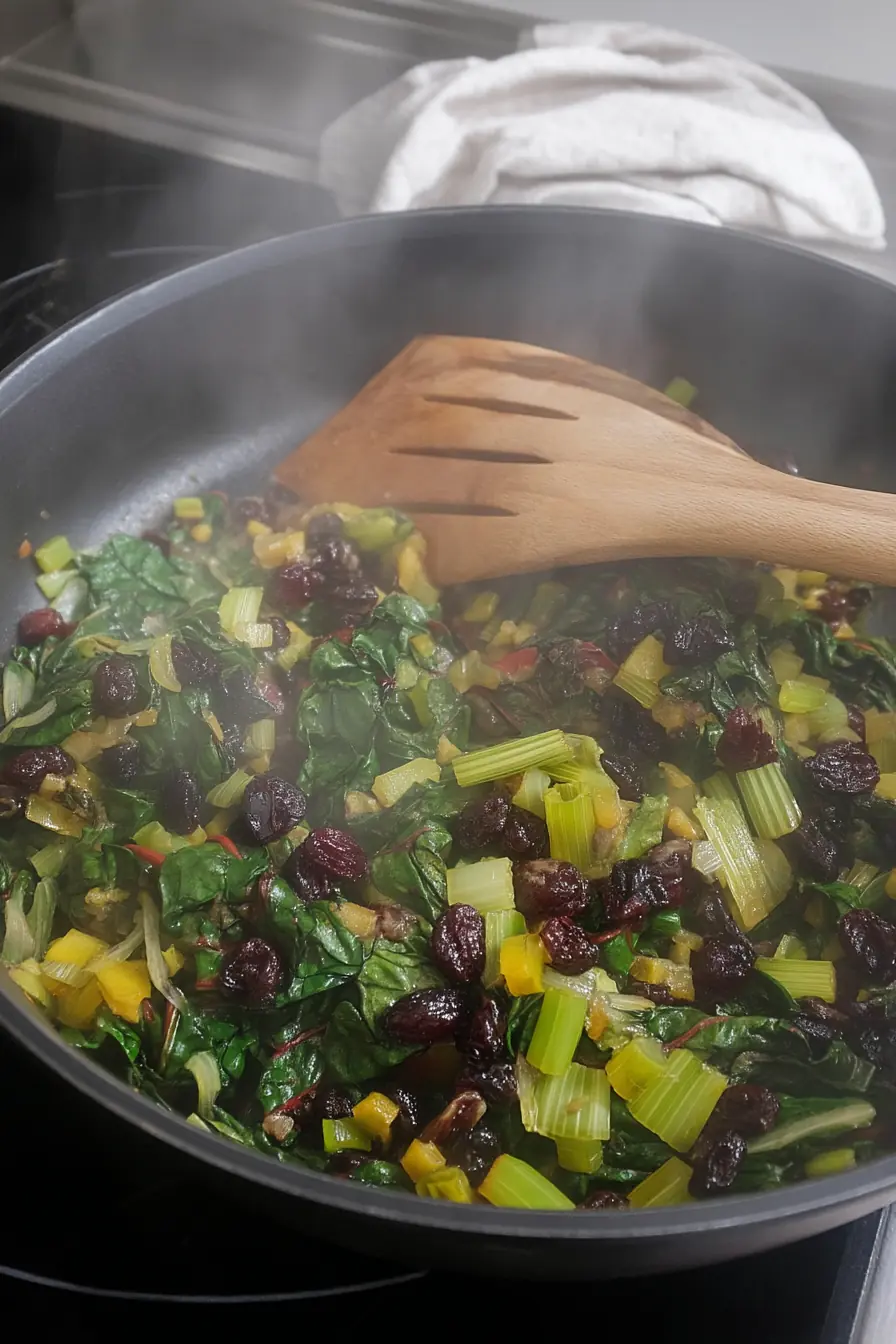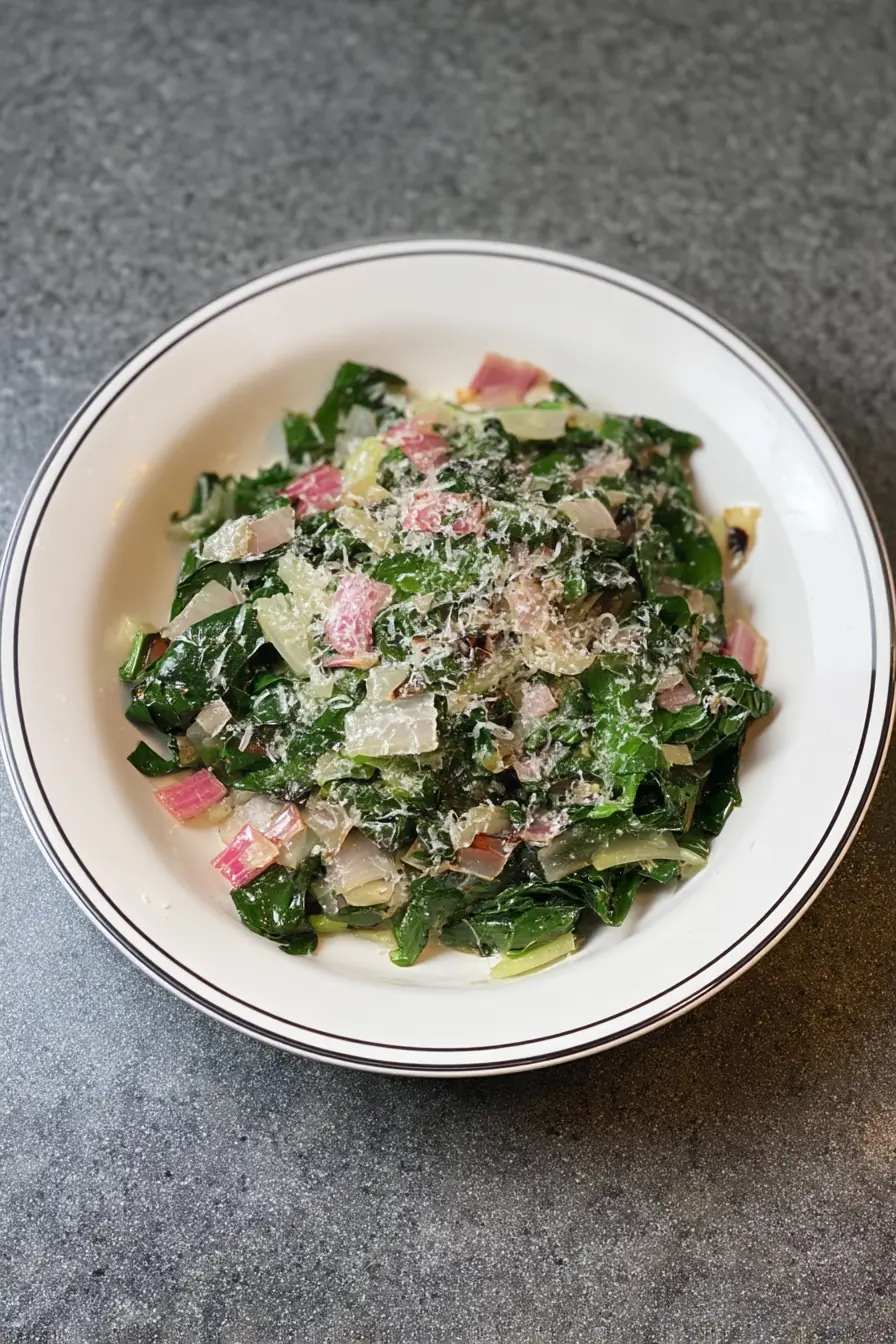Table of Contents
If you’ve ever wondered how to cook Swiss chard so it’s not bitter, this Irresistible Sautéed Swiss Chard is your answer—quick, flavorful, and done in just 15 minutes. This simple side dish brings out the natural sweetness of rainbow chard with garlic, lemon, and a touch of Parmesan. Whether you’re looking for easy Swiss chard recipes to use up garden greens or a vibrant alternative to spinach, this one checks every box. It’s light enough for summer and cozy enough for fall—plus, it pairs effortlessly with everything from roast chicken to pasta. Ready to transform a humble bunch of greens into something crave-worthy? Let’s get into it.

Irresistible Sautéed Swiss Chard in Just 15 Minutes
- Prep Time: 5 minutes
- Cook Time: 10 minutes
- Total Time: 15 minutes
- Yield: 2–3 servings
- Category: Mains
- Method: Sauté
- Cuisine: Mediterranean
- Diet: Vegetarian
Description
Quick, vibrant, and packed with flavor, this sautéed Swiss chard recipe is your new go-to side dish. With lemon, garlic, and Parmesan, it’s ready in just 15 minutes.
Ingredients
- 1 bunch of Swiss chard (rainbow or red), stems and leaves chopped separately
- 2 tablespoons olive oil
- 2 tablespoons unsalted butter
- ½ small red onion, finely diced
- 1 tablespoon garlic, minced
- ½ cup dry white wine
- 1 tablespoon fresh lemon juice (or more to taste)
- 2 tablespoons freshly grated Parmesan cheese
- A pinch of salt, to taste
Instructions
- Prep the chard: Wash thoroughly, then chop stems and leaves separately.
- Heat skillet: Warm olive oil and butter over medium-high heat.
- Sauté aromatics: Add onion and garlic; cook 30–60 seconds.
- Cook stems: Add chard stems and wine. Simmer for 4–5 minutes.
- Add leaves: Stir in chopped leaves; cook until just wilted (2–3 mins).
- Finish: Add lemon juice, Parmesan, and a pinch of salt. Stir and serve hot.
Notes
- This recipe works with any variety of Swiss chard.
- For a vegan version, omit the butter and Parmesan or use plant-based alternatives.
- Pair with grilled proteins or serve over polenta for a light main.
Nutrition
- Serving Size: 1 cup
- Calories: 160
- Sugar: 2g
- Sodium: 140mg
- Fat: 13g
- Saturated Fat: 6g
- Unsaturated Fat: 7g
- Trans Fat: 0g
- Carbohydrates: 7g
- Fiber: 3g
- Protein: 3g
- Cholesterol: 15mg
Keywords: sauteed swiss chard, garlic swiss chard, swiss chard side dish, rainbow chard, cooking swiss chard, quick swiss chard recipes
Save This Recipe for Later

Loved this Irresistible Sautéed Swiss Chard? Don’t let it slip away!
📌 Pin it here to save for your next weeknight dinner or garden harvest.
💬 Share it with a friend who’s swimming in Swiss chard and needs an easy, delicious way to use it up.
Want more easy, flavorful recipes like this one? Subscribe to our newsletter for fresh ideas, seasonal favorites, and tips that make cooking fun again—straight to your inbox.
Because the best meals are worth remembering (and repeating).
What You’ll Need

Before we start sautéing, let’s make sure you’ve got everything prepped and ready. This dish comes together fast, so having your ingredients and tools within reach will make things smooth and stress-free. Here’s what you’ll need to make this sauteed Swiss chard sing:
Ingredients
- 1 bunch of Swiss chard (rainbow or red), stems and leaves separated and chopped
- 2 tablespoons of olive oil
- 2 tablespoons of unsalted butter
- ½ small red onion, finely diced
- 1 tablespoon of garlic, minced (about 2–3 cloves)
- ½ cup of dry white wine (like Sauvignon Blanc or Pinot Grigio)
- 1 tablespoon of fresh lemon juice, or more to taste
- 2 tablespoons of freshly grated Parmesan cheese
- A pinch of salt, to finish
Equipment
- Large skillet or sauté pan – preferably nonstick or stainless steel for even heat
- Sharp knife – for slicing the chard and onion
- Cutting board
- Measuring spoons and cups
- Wooden spoon or spatula – for stirring without bruising the greens
That’s it—no fancy gadgets, no hard-to-find ingredients. Just a few staples and one beautiful bunch of Swiss chard. Let’s move on to turning these into something seriously tasty.
Detailed Cooking Instructions

Follow these easy steps to make perfectly sautéed Swiss chard in just 15 minutes. Keep the heat moderate and the timing sharp — the magic is in not overcooking.
Step-by-Step Instructions
1: Prep the Swiss chard
Rinse the chard thoroughly to remove any grit. Separate the stems from the leaves. Chop the stems into small pieces and coarsely chop the leaves.
2: Heat the skillet
Place a large skillet over medium-high heat. Add the olive oil and butter. Let the butter melt and foam slightly.
3: Sauté the aromatics
Add the diced red onion and minced garlic to the pan. Stir constantly for 30 seconds to 1 minute, until fragrant and just softened.
4: Cook the stems
Toss in the chopped Swiss chard stems. Pour in the white wine. Let it simmer for 4–5 minutes, or until the stems start to soften.
5: Add the leaves
Add the chopped chard leaves to the pan. Stir gently and cook for about 2–3 minutes, just until wilted. Don’t overcook—chard should stay vibrant and tender.
6: Finish and season
Drizzle in the lemon juice. Stir in the grated Parmesan until it melts into the greens. Taste and add a pinch of salt if needed.
7: Serve hot
Transfer to a serving dish or plate straight from the pan. Serve immediately while warm and glossy.
That’s it—fast, flavorful, and a great way to enjoy seasonal greens without fuss.
Tips & Tricks

These simple tips will help you get the most out of your sautéed Swiss chard—whether you’re new to cooking greens or just want to elevate your side dish game.
Avoid bitterness
Wondering how to cook Swiss chard so it’s not bitter? The key is balance. Sautéing the stems first softens their edge, and the acidity from lemon juice brightens and smooths the overall flavor. Don’t skip it.
Make it a meal
Turn this into a main by adding white beans, chickpeas, or sautéed mushrooms. For heartier options, try it over polenta, with pasta, or served alongside grilled chicken or baked fish.
Use up extra greens
Got more greens in the fridge? This recipe works just as well with kale and Swiss chard, or a mix of spinach and chard. It’s a great way to use whatever’s fresh or in season.
Store and reheat
Leftovers? Store in an airtight container in the fridge for up to 2 days. Reheat gently in a pan over low heat to preserve texture and flavor. Swiss chard doesn’t freeze well when cooked—it turns mushy—so enjoy it fresh when possible.
Parmesan swaps
No Parmesan? No problem. Try Pecorino Romano for a sharper bite, or skip the cheese entirely for a lighter, dairy-free version.
Want it spicy?
Add a pinch of red pepper flakes while sautéing the garlic. Just enough heat makes this garlic sautéed Swiss chard even more exciting without overpowering the greens.
These small adjustments give you flexibility while keeping the dish fresh, fast, and packed with flavor.
You Might Also Like
Looking for more easy and flavorful dishes to pair with your sautéed Swiss chard? These reader-favorite recipes bring bold flavor, seasonal ingredients, and weeknight simplicity to the table:
Another vibrant way to enjoy fresh greens—perfect if you’ve got extra chard to use up.
A protein-packed main dish with zesty lemon and garlic that complements your chard beautifully.
Rich, comforting, and surprisingly low-carb—this cheesy bake is a crowd-pleasing side that pairs well with any sautéed greens.
Each of these recipes brings something different to the plate, making it easy to build a satisfying meal from simple, wholesome ingredients.
Frequently Asked Questions
Yes, and you should! The stems add crunch and flavor. Just cook them a few minutes before adding the leaves so they soften properly.
Balance is key—sautéing in butter and olive oil, then finishing with lemon juice, helps mellow any bitterness while enhancing the natural flavor.
Absolutely. Red, green, and rainbow chard can all be used interchangeably in this recipe. Rainbow chard adds extra color to the dish.
Yes, and in some ways, even better. It holds up better in sautés, has a slightly earthier flavor, and offers a different texture that many home cooks love.
It’s not ideal. Cooked chard tends to become mushy when frozen. For best results, store leftovers in the fridge and enjoy within two days.



